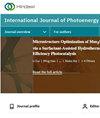Harmonic Analysis of Large Grid-Connected PV Systems in Distribution Networks: A Saudi Case Study
IF 2.1
4区 工程技术
Q3 CHEMISTRY, PHYSICAL
引用次数: 1
Abstract
The increasing penetration of grid-connected PV rooftops at the distribution level still entails significant technical challenges affecting seriously the power quality indices such as harmonics and voltage fluctuations. Owing to the intermittent nature of renewable resources, the changing incident energy from renewables can generate considerable amounts of harmonics. Moreover, power electronic devices and nonlinear loads that are used frequently in the industry may exaggerate the harmonic distortions as well. Accordingly, utilizing suitable filtration techniques for harmonic reduction is crucial. In order to evaluate the impacts of grid-connected PVs in modern grids, a case study on power quality and voltage profile is conducted with a large grid-connected PV microgrid of 9570 kW, feeding a large hospital project in Saudi Arabia as an initial phase of implementing this project in the future. For eliminating the possible increase in harmonic distortion, a single-tuned filter is used to cope with the permissible limits according to the known IEEE standards. This filtering technique is chosen due to its advantages including the simplicity, suitability for significant integer harmonic orders, and low cost. For evaluation tests, a detailed simulation is developed by the ETAP program for the overall selected project as well as the aimed PV subsystem. Several simulation tests are conducted to investigate the harmonic distortion problem. The results show a significant reduction in the individual harmonic distortion (IHD) and the total harmonic distortion (THD) below 8% according to considered IEEE standards for LV networks. Both 6 and 12 pule inverters are considered. This is considered an important step in the realization of such large PV projects in the field.配电网中大型并网光伏系统的谐波分析:沙特案例研究
随着光伏并网屋顶在配电网的不断普及,对电网谐波和电压波动等电能质量指标的影响仍然存在重大的技术挑战。由于可再生能源的间歇性,可再生能源不断变化的入射能量可以产生相当数量的谐波。此外,工业中经常使用的电力电子设备和非线性负载也会使谐波失真放大。因此,利用合适的滤波技术来降低谐波是至关重要的。为了评估并网光伏对现代电网的影响,以9570 kW的大型并网光伏微电网为例,对电能质量和电压分布进行了案例研究,为沙特阿拉伯的一个大型医院项目供电,作为该项目未来实施的初始阶段。为了消除可能增加的谐波失真,根据已知的IEEE标准,使用单调谐滤波器来处理允许的限制。选择这种滤波技术是因为它具有简单、适用于显著整数次谐波和低成本等优点。为了进行评估测试,ETAP程序对整个选定项目以及目标PV子系统进行了详细的模拟。为了研究谐波失真问题,进行了多次仿真试验。结果表明,根据考虑的IEEE低压网络标准,个体谐波失真(IHD)和总谐波失真(THD)显著降低至8%以下。考虑6和12极逆变器。这被认为是在该领域实现此类大型光伏项目的重要一步。
本文章由计算机程序翻译,如有差异,请以英文原文为准。
求助全文
约1分钟内获得全文
求助全文
来源期刊
CiteScore
6.00
自引率
3.10%
发文量
128
审稿时长
3.6 months
期刊介绍:
International Journal of Photoenergy is a peer-reviewed, open access journal that publishes original research articles as well as review articles in all areas of photoenergy. The journal consolidates research activities in photochemistry and solar energy utilization into a single and unique forum for discussing and sharing knowledge.
The journal covers the following topics and applications:
- Photocatalysis
- Photostability and Toxicity of Drugs and UV-Photoprotection
- Solar Energy
- Artificial Light Harvesting Systems
- Photomedicine
- Photo Nanosystems
- Nano Tools for Solar Energy and Photochemistry
- Solar Chemistry
- Photochromism
- Organic Light-Emitting Diodes
- PV Systems
- Nano Structured Solar Cells

 求助内容:
求助内容: 应助结果提醒方式:
应助结果提醒方式:


